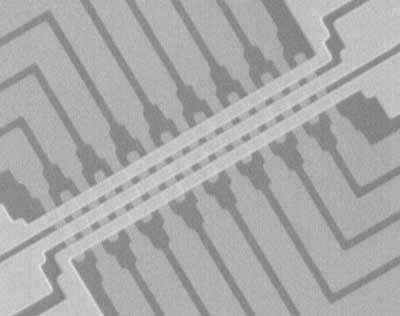Memristor
A memristor (named as a portmanteau of memory and resistor) is a non-volatile electronic memory device that was first theorized by Leon Ong Chua in 1971 as the fourth fundamental two-terminal circuit element following the resistor, the capacitor, and the inductor (IEEE Transactions on Circuit Theory, "Memristor-The missing circuit element").
Its special property is that its resistance can be programmed (resistor function) and subsequently remains stored (memory function). Unlike other memories that exist today in modern electronics, memristors are stable and remember their state even if the device loses power.
However, it was only almost 40 years later that the first practical device was fabricated. This was in 2008, when a group led by Stanley Williams at HP Research Labs realized that switching of the resistance between a conducting and less conducting state in metal-oxide thin-film devices was showing Leon Chua's memristor behavior. Here, R. Stanley Williams gives us a quick whiteboard talk about how the device works:
Since then, the field has rapidly grown and there has been a huge amount of work in the area. Very high levels of endurance (120 billion cycles) and retention (10 years or more) have recently been achieved in memristor devices (Nature Nanotechnology, "Memristor crossbar arrays with 6-nm half-pitch and 2-nm critical dimension") and ultrahigh density crossbar arrays, including multiple layer stacking, have been realized with scalability down to 2-10 nanometers.
Today, most computers use random access memory (RAM), which moves very quickly as a user works but does not retain unsaved data if power is lost. Flash drives, on the other hand, store information when they are not powered but work much slower. Memristors could provide a memory that is the best of both worlds: fast and reliable.
Memristors have several attractive features that make them compelling for computer scientists: They require less energy to operate and are faster than present solid-state storage technologies and they can store at least twice as much data in the same area. Memristors are virtually immune from radiation, which can disrupt transistor-based technologies. Also, memristors can enable computers that turn on and off like a light switch.

Fabrication of Memristors
Different from an electrical resistor that has a fixed resistance, a memristor possesses a voltage-dependent resistance, which means that a material's electric properties are key. A memristor material must have a resistance that can reversibly change with voltage. Memristors have a very simple structure – often just a thin film made of titanium dioxide between two metal electrodes.
Scientists have been able to show that various materials such as metal oxides, chalcogenides, amorphous silicon, carbon, and polymer-nanoparticle composite materials exhibit memristive phenomena.
They even demonstrated that natural biomaterials like protein can be used to fabricate bipolar memristive nanodevices.

Researchers also have demonstrated the ability to reversibly control the learning properties of memristors via optical means, i.e. light.
The high interest in memristor devices also stems from the fact that these devices emulate the memory and learning properties of biological synapses. i.e. the electrical resistance value of the device is dependent on the history of the current flowing through it.
Neuromorphic computing
There is a huge effort underway to use memristor devices in neuromorphic computing applications and it is now reasonable to imagine the development of a new generation of artificial intelligent devices with very low power consumption (non-volatile), ultra-fast performance and high-density integration.
Computers have separate processing and memory storage units, whereas the brain uses neurons to perform both functions. This is one reason why neural networks can achieve complicated computation with significantly lower energy consumption compared to a digital computer.
One of the key components of any neuromorphic effort – the design of artificial neural systems with physical architectures inspired by biological nervous systems – is the design of artificial synapses. The human brain contains vastly more synapses than neurons – by a factor of about 10,000 – and therefore it is necessary to develop a nanoscale, low power, synapse-like device if scientists want to scale neuromorphic circuits towards the human brain level.
A memristor is similar to a synapse in the human brain because it exhibits the same switching characteristics, i.e. it is able, with a high level of plasticity, to modify the efficiency of signal transfer between neurons under the influence of the transfer itself. That's why researchers are hopeful to use memristors for the fabrication of electronic synapses for neuromorphic computing that mimics some of the aspects of learning and computation in human brains.
Neuroscientists have argued that competition and cooperation behaviors among synapses are very important. Already, researchers have fabricated memristive devices that allows them to implement a faithful model of these synaptic behaviors in a solid-state system.
